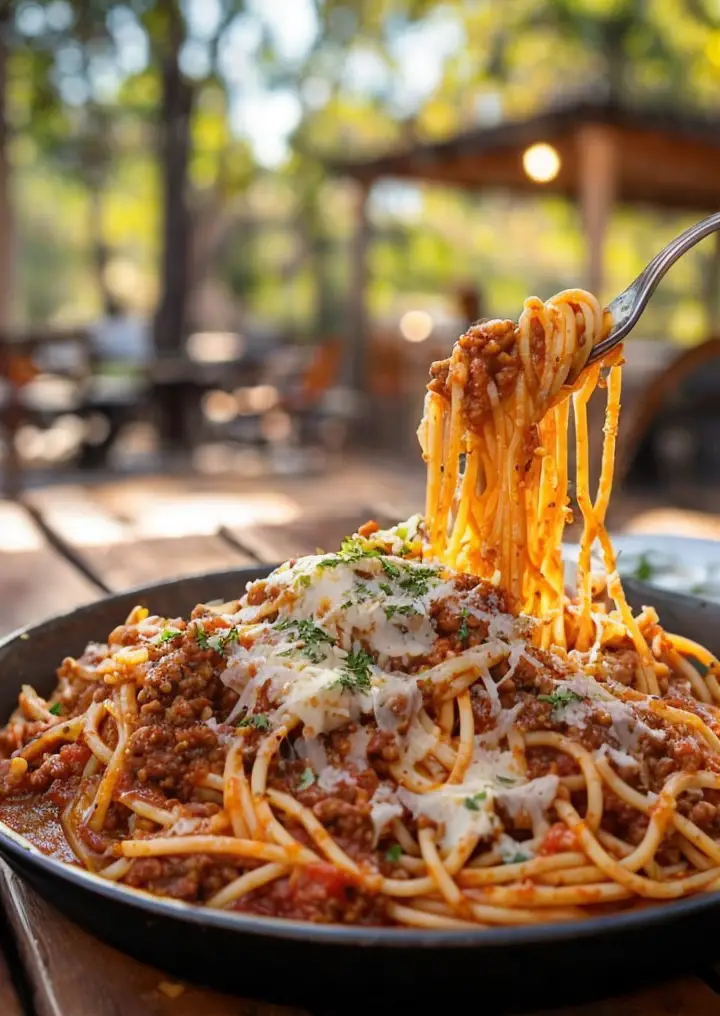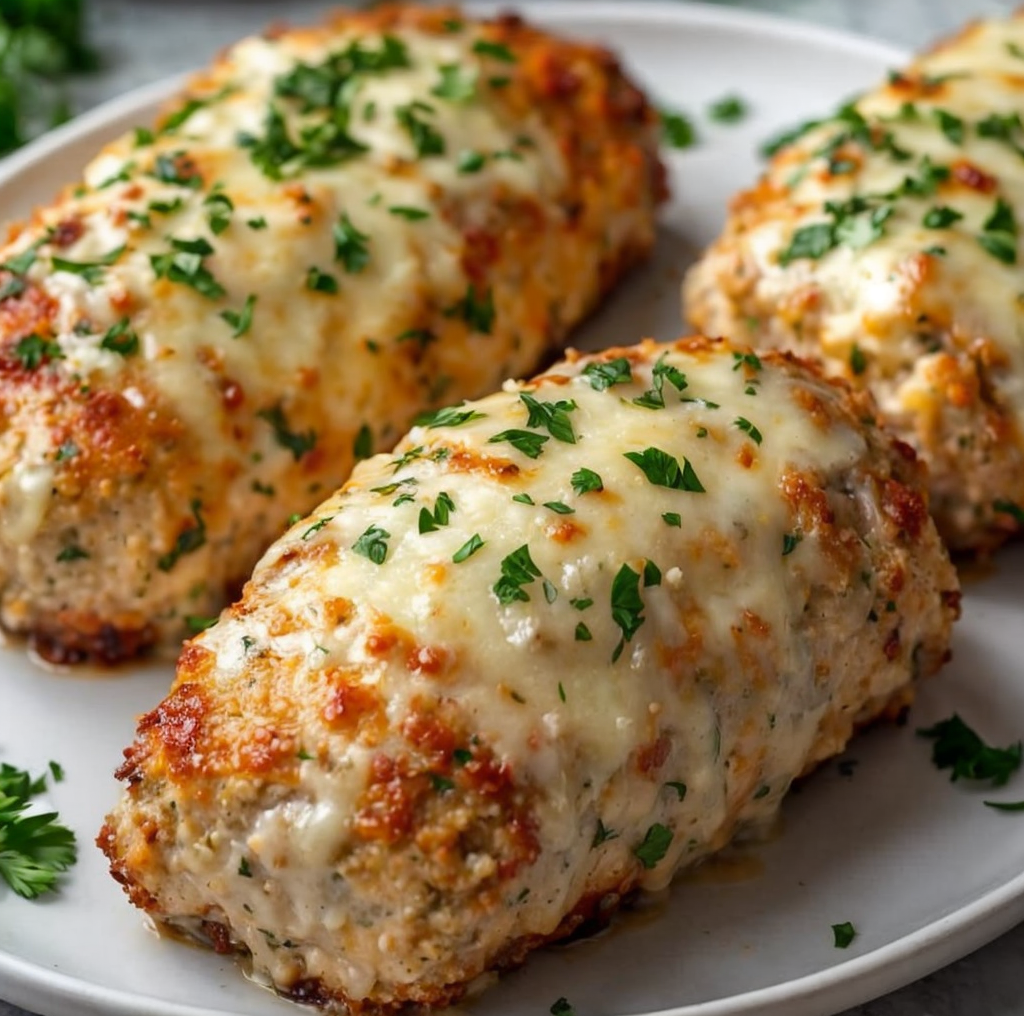Mediterranean Spaghetti with Hearty Meat Sauce: A Flavorful Journey to the Mediterranean
Introducing the Mediterranean Spaghetti with Hearty Meat Sauce, a recipe that transports your taste buds straight to the sun-soaked shores of the Mediterranean. This delightful dish marries perfectly cooked spaghetti with a rich, savory meat sauce bursting with flavors of garlic, herbs, and ripe tomatoes. Every bite of this pasta is a celebration of vibrant ingredients, making it an iconic meal for family gatherings or a cozy evening dinner. With its aromatic profile and hearty texture, this dish is guaranteed to become a favorite at your dining table.
Imagine twirling strands of spaghetti around your fork, each twirl capturing the essence of the Mediterranean. The sauce is thick, rich, and comforting, crafted from ground beef simmered with tomatoes, aromatic vegetables, and a medley of spices that promise to tantalize your palate. Garnished with fresh basil and a sprinkle of Parmesan, this meal is not only delicious but also visually stunning, inviting everyone to dig in. Whether served on a casual weeknight or a special occasion, Mediterranean Spaghetti with Hearty Meat Sauce is a dish that unites everyone over good food and great company.
Quick Recipe Highlights
- Flavor Profile: This dish features a robust flavor profile characterized by rich meatiness, acidity from tomatoes, and herbaceous notes from fresh basil and oregano.
- Texture: The combination of tender spaghetti and hearty meat sauce creates a delightful contrast, making every bite comforting and satisfying.
- Aroma: The enticing aroma of sautéed garlic, onion, and herbs fills your kitchen, creating an inviting atmosphere for your meal.
- Visual Appeal: The vibrant red of the sauce against the backdrop of golden spaghetti makes this dish visually appealing and mouthwatering.
- Skill Level Needed: With straightforward steps, this recipe is perfect for cooks of all skill levels, providing an opportunity for beginners to enhance their pasta cooking techniques.
- Special Equipment: A large pot for cooking spaghetti and a skillet for preparing the meat sauce are essential, making this recipe easily manageable.
Recipe Overview
- Difficulty Level: This recipe is categorized as medium difficulty due to the need for proper sauce preparation and pasta cooking, ideal for intermediate cooks looking to refine their skills.
- Category: Mediterranean Spaghetti fits perfectly into the pasta category, serving as a fantastic main course for any meal.
- Cuisine: This recipe draws its influences from Mediterranean cuisine, known for its use of fresh herbs and wholesome ingredients that celebrate natural flavors.
- Cost: The ingredients for this recipe are relatively affordable, making it a cost-effective choice for families and individuals alike.
- Season: While delicious year-round, this dish is particularly comforting in fall and winter when heartier meals are sought after.
- Occasion: Mediterranean Spaghetti with Hearty Meat Sauce is excellent for cozy family dinners, gatherings with friends, or even festive occasions like birthdays and anniversaries.
Why You’ll Love This Recipe
Mediterranean Spaghetti with Hearty Meat Sauce perfectly balances taste and texture, providing a meal that is both indulgent and satisfying. The rich flavors from the meat sauce complement the al dente pasta, creating a culinary experience that speaks of warmth and comfort. With every bite, you’ll appreciate the depth of flavor crafted by fresh herbs and quality ingredients, pulling you into a world of delightful tastes.
Convenience is key with this recipe. From preparation to serving, this dish can be made in less than an hour, making it a perfect choice for busy weeknights or last-minute gatherings. The straightforward steps allow beginners and experienced cooks alike to create a home-cooked meal with ease. Plus, the versatility of the hearty sauce means you can prepare it ahead of time, allowing for quick reheating when needed.
Nutritionally, this dish boasts a good balance of protein, carbohydrates, and essential vitamins, thanks to the lean meat and tomato base enriched with vegetables. With the addition of fiber-rich spaghetti and the option for whole-grain versions, you can easily adapt it to suit your health needs without sacrificing flavor.
Socially, Mediterranean Spaghetti is a dish that brings people together. Its communal nature encourages sharing and conversation, making it perfect for dinner parties or family meals. You can easily scale the recipe to accommodate larger gatherings, ensuring that everyone enjoys a hearty meal.
Finally, this recipe is cost-effective and accessible, using ingredients commonly found in your pantry or local grocery store. With minimal investment, you can serve a filling dish that satisfies both the stomach and the soul, proving that great taste doesn’t have to come at a high price.
Historical Background and Cultural Significance
The roots of Mediterranean cuisine are as diverse as the countries that surround the Mediterranean Sea. Originating from a blend of cultures, this cuisine brings together the flavors of Greece, Italy, and North Africa, all of which emphasize fresh ingredients and wholesome cooking methods. Pasta, a staple in Italian tradition, transforms into a canvas for this rich meat sauce, showcasing the importance of regional culinary practices.
The cultural significance of spaghetti and meat sauce reflects a communal approach to dining, where meals are often enjoyed together. In many Mediterranean countries, sharing food reflects hospitality and brings people closer, turning dinner into a treasured ritual. With family-style servings and communal eating, Mediterranean spaghetti promotes togetherness and connection.
As the recipe has evolved, it has embraced modifications based on regional ingredients and preferences. For instance, variations of this dish might include the use of lamb or turkey instead of beef, or incorporating seasonal vegetables to enhance flavor and nutrition. The flexibility of this recipe demonstrates how traditional dishes can adapt while still remaining true to their origins.
Regional variations of Mediterranean Spaghetti are a testament to local tastes and preferences, with each region adding their unique twist. From the addition of olives in southern Italy to the use of spicy pepper in Spain, these adaptations not only reflect local ingredients but also celebrate the culinary diversity of the Mediterranean region.
Ingredient Deep Dive
Ground Beef: A key player in this dish, ground beef provides both flavor and protein. Historically, beef has been a staple protein across many cultures. Nutritionally, it offers essential vitamins and minerals, including iron and B12. When selecting ground beef, choose grass-fed options for superior flavor and health benefits. Store it in the coldest part of your refrigerator and consume it within a couple of days, or freeze it for longer preservation. If you’re looking for substitutions, ground turkey or lentils make great alternatives for lighter or vegetarian versions.
Spaghetti: This beloved pasta is the foundation of the dish, originating from Italy. Rich in carbohydrates, spaghetti serves as a great energy source. Opt for whole grain or gluten-free alternatives for extra nutrition. Store dried spaghetti in a cool, dry place, and keep fresh pasta in the refrigerator for a few days. If you’re out of spaghetti, alternatives like penne or fusilli work well, offering different textures to the dish.
Tomatoes: Tomatoes are crucial for the sauce, bringing acidity and brightness. Originating in South America, they became integral to Mediterranean cooking in the 16th century. Rich in vitamins C and K, tomatoes are also high in antioxidants. When selecting tomatoes, look for those that are firm and vibrant in color. Canned tomatoes are a great pantry staple that ensures you can cook this dish year-round. For a twist, consider substituting cherry tomatoes for added sweetness.
Garlic and Onion: These aromatics provide depth of flavor in the sauce. Both are known for their health benefits including heart health and immune support. When selecting, choose fresh garlic that is firm and free of sprouts. Store onions in a cool, dark place, and ideally separate from potatoes to extend their shelf life. If you need substitutes, shallots can offer a similar flavor profile.
Herbs (Basil and Oregano): Fresh herbs elevate the taste of Mediterranean dishes. They add freshness and aromatic qualities that enhance the overall flavor. Basil is often associated with Italian cuisine, while oregano has historical ties to Greece. When choosing herbs, fresh is preferred, but dried herbs work as a suitable substitute. Store fresh herbs in the refrigerator and dried ones in a cool, dark pantry. Both enhance the dish with their unique profiles.
Common Mistakes to Avoid
- Overcooking the pasta: Make sure to test the spaghetti a minute or two before the package instructions suggest. Al dente pasta holds up better against the sauce.
- Skimping on seasoning: Seasoning the sauce at each stage of cooking is crucial. Add salt and spices throughout to develop a more complex flavor.
- Using low-quality meat: The meat is the star of the sauce, so investing in good-quality ground beef will greatly affect the dish’s taste and texture.
- Not allowing flavors to develop: Take your time when simmering the sauce. Allowing it to cook longer helps meld the flavors together.
- Adding cold meat to the pan: Let your meat come to room temperature before cooking; this ensures even browning.
- Ignoring fresh herbs: Fresh herbs can elevate your sauce and adding them at the right moment enhances their flavor. Avoid overcooking them.
- Skipping the garlic: Garlic adds depth to your sauce. Be cautious not to burn it, as it can turn bitter.
- Not tasting as you go: Always taste your sauce before serving. Adjusting seasonings at the end can greatly improve the final outcome.
- Forgetting to reserve pasta water: The starchy pasta water is perfect for adjusting the sauce consistency, ensuring it clings beautifully to every strand.
- Overloading the sauce with too many ingredients: Less is often more. Stick to the core ingredients for best results and let their natural flavors shine.
Essential Techniques
Cooking Pasta: Properly cooking pasta is essential for achieving the right texture. Start with a large pot of boiling salted water, add the spaghetti, and stir occasionally. Cook until al dente—firm to the bite—then drain and reserve some pasta water. Avoid rinsing, as this removes the starch needed for sauce adherence.
Making a Hearty Meat Sauce: Begin by browning the ground beef in a skillet, breaking it apart for even cooking. Once browned, add onions and garlic, sautéing until translucent. Slowly add tomatoes and herbs, allowing the sauce to simmer so all flavors develop. Adjust the seasoning and let it cook until thickened to your desired consistency.
Pro Tips for Perfect Mediterranean Spaghetti with Hearty Meat Sauce
1. Always use a large pot for boiling your pasta to prevent sticking and allow for even cooking.
2. Opt for high-quality canned tomatoes—San Marzano are a favorite for their sweetness and richness.
3. When simmering your sauce, a longer cook time allows the flavors to enhance, but be careful not to let it dry out.
4. Don’t be afraid to add red wine to your meat sauce for depth; just let it reduce a little before serving to eliminate the alcohol taste.
5. Fresh herbs should be added toward the end of cooking to retain their flavor; dried herbs can be added earlier in the process.
6. If you plan on leftovers, store the pasta and sauce separately to prevent the pasta from becoming mushy.
7. For a spicy kick, consider adding red pepper flakes to the sauce while it simmers for an exciting flavor twist.
8. Take your time when sautéing vegetables; properly caramelized onions enhance the sweetness and complexity of the dish.
Variations and Adaptations
Regional variations of Mediterranean Spaghetti can include different types of meat, such as lamb or chicken, which add unique flavors and profiles. You can also experiment with seasonal adaptations; incorporating fresh vegetables like zucchini or bell peppers in the spring and summer can lighten the meal.
For those with dietary restrictions, gluten-free pasta options are widely available without sacrificing taste. Vegan adaptations could replace ground beef with lentils or mushrooms, providing a hearty alternative while keeping the essence of the dish intact.
Flavor variations can be added through spices and herbs, such as substituting basil with parsley or introducing a hint of cinnamon for a Moroccan twist. If you’re looking for a texture modification, adding crushed nuts or seeds can introduce a delightful crunch.
Lastly, presentation alternatives could include serving the spaghetti in individual bowls, garnished with a drizzle of olive oil and freshly grated cheese for a restaurant-quality finish.
Serving and Presentation Guide
Plating your Mediterranean Spaghetti beautifully enhances the dining experience. Start by twirling the spaghetti into a nest shape in the center of a warm plate, allowing the sauce to cascade around it. A sprinkle of freshly shredded Parmesan and torn basil leaves on top adds both flavor and visual appeal.
Traditional accompaniments like garlic bread or a side Greek salad can complement this dish well, rounding out the meal. You might also consider modern serving suggestions such as using single-serve cast iron skillets or mason jars for a rustic presentation.
Temperature is crucial; serve immediately after cooking to savor the pasta’s texture. For portion control, consider using kitchen scales to measure servings evenly, ensuring everyone gets their fair share.
Wine and Beverage Pairing
When it comes to wine pairings, a medium-bodied red wine like Chianti or Sangiovese complements the rich flavors of Mediterranean Spaghetti beautifully. Its acidity cuts through the meat sauce, enhancing the overall tasting experience.
For non-alcoholic alternatives, a sparkling water with a slice of lemon provides a refreshing balance. Additionally, if you wish to indulge in coffee or tea after the meal, a light herbal tea can aid digestion while providing a pleasant contrast to the robust flavors of the dish.
Temperature plays a role here too; red wines should ideally be served slightly cooler than room temperature for optimal enjoyment, while sparkling beverages can be chilled.
Storage and Shelf Life
To ensure the longevity of your Mediterranean Spaghetti, proper storage methods are essential. Place any leftovers in airtight containers and refrigerate, where they can last for up to three days. If you wish to keep it longer, freezing is an option; the dish will remain good for about three months when properly sealed.
Always check for signs of spoilage before consuming—look for off-odors or unusual colors. When reheating, ensure it’s done thoroughly to an internal temperature of 165°F, and consider adding a splash of water to rehydrate the pasta.
Freezing guidelines suggest separating the meat sauce and pasta before freezing, as they can maintain their texture better this way. Simply thaw and reheat when ready to serve again.
Make Ahead Strategies
For those short on time, several make-ahead strategies can be employed to facilitate cooking. You can prepare the meat sauce a day in advance, storing it in the refrigerator to allow the flavors to meld further. Cook the spaghetti fresh just before serving for the best texture.
If preparing ingredients beforehand, chop your vegetables and store them in airtight containers, ready for use. To ensure quality, keep a close watch on the timeline for each step, as preparing elements too far in advance can occasionally alter their taste and texture.
When assembling the dish, have everything ready to go. The last-minute touch of freshly chopped herbs can be added just before serving to maintain their vibrant flavor. For reheating, do so gently in a saucepan, adding pasta cooking water to restore moisture.
Scaling Instructions
If you’re looking to scale your Mediterranean Spaghetti recipe, adjusting ingredients becomes simple. For halving the recipe, use a kitchen scale to measure out ingredients accurately and reduce cooking times accordingly.
When doubling or tripling the recipe for larger gatherings, ensure you have a sufficiently large pot for boiling and a larger skillet for the sauce. This will allow for even cooking without overcrowding the pan.
Be mindful of timing modifications: while the cooking duration may stay consistent, preparing ingredients can take longer when larger batches are involved. Additionally, consider storage considerations; you may need to use multiple containers when freezing or refrigerating leftovers.
Nutritional Deep Dive
When analyzing the nutrition of Mediterranean Spaghetti with Hearty Meat Sauce, the macro breakdown reveals a good balance of macronutrients: carbohydrates from spaghetti, protein from ground beef, and healthy fats if olive oil is used.
Micronutrient analysis shows that this dish is rich in vitamins such as A, C, and K, mainly sourced from tomatoes and fresh herbs. Additionally, ground beef provides key minerals, including iron and zinc, instrumental for maintaining energy levels.
Health benefits include high protein content aiding muscle repair and maintenance, while dietary fiber from whole grain pasta supports digestive health. Portion analysis is vital; a serving of this dish typically contains around 600-700 calories depending on portion sizing.
For those on weight management journeys, balance is critical—consider pairing the dish with a side salad to increase volume while keeping calorie intake in check.
Dietary Adaptations
For those following a gluten-free diet, there are many great alternatives to traditional spaghetti, like zucchini noodles or gluten-free pasta brands that maintain great texture and flavor.
A dairy-free adaptation can be achieved by omitting cheese or using nutritional yeast as a cheese substitute, providing a similar umami flavor without the dairy content.
Vegetarians and vegans can replace the ground beef in the recipe with lentils or crumbled textured vegetable protein, ensuring protein needs are met without any meat.
For low-carb dieters, using spiralized vegetables as a base instead of traditional pasta is an excellent option, maintaining a comforting feel with much fewer carbohydrates.
For those adhering to a keto lifestyle, consider opting for cauliflower rice in lieu of pasta, while also being mindful of the tomato content to ensure carbohydrate levels stay low.
For paleo followers, swapping out the pasta for spiralized vegetables like zucchini or sweet potatoes preserves the dish’s integrity while adhering to dietary guidelines.
Troubleshooting Guide
If you find your sauce too watery, allow it to simmer uncovered for a while to reduce excess liquid, enhancing the overall flavor. For texture issues, if the spaghetti is mushy, ensure to cook for the recommended time next time and check for al dente during cooking.
If your dish tastes bland, it could be due to insufficient seasoning. Adjust this by adding salt, and consider including umami-rich ingredients like Worcestershire sauce or more herbs for depth.
Temperature problems can arise when serving; keeping the sauce heated while cooking the pasta is essential, preventing cold servings. Always taste before serving to ensure the temperature is just right.
If you experience equipment challenges, like a pot boiling over, reduce the heat slightly and stir to keep even bubbling. Ingredient substitutions may yield varied results, so approach swaps cautiously, always considering how flavors will meld together.
Timing concerns often stem from trying to multitask; ensure you have all ingredients prepped beforehand to facilitate a smoother cooking experience.
Recipe Success Stories
Our community has embraced Mediterranean Spaghetti with Hearty Meat Sauce, sharing feedback on the delightful flavors and comforting textures. Many have highlighted the ease of preparation, praising how quickly the dish comes together without compromising on taste, making it a go-to for weekday dinners.
Readers have also reported successful variations, such as incorporating local vegetables or swapping out proteins, proving the dish’s versatility. Sharing their adaptations has fostered a sense of community, creating a platform for engagement among food lovers.
Photography tips have proven invaluable too, with community members showcasing their final creations on social media. This not only inspires others to try the recipe but also reflects the personal touches people add to the dish, making each serving unique.
Feedback regarding the meal’s aroma enhancing the dining experience has also been a recurring theme; many cooks have noted how inviting their homes feel while preparing this dish, often leading to family members getting involved in the cooking process.
Ultimately, the success stories surrounding Mediterranean Spaghetti with Hearty Meat Sauce celebrate both the recipe’s authenticity and the memories created around the dinner table.
Frequently Asked Questions
Can I make this dish vegetarian? Yes, you can easily make Mediterranean Spaghetti vegetarian by substituting ground beef with lentils, mushrooms, or even a meat substitute product for a similar texture and taste.
What herbs work well with this recipe? Fresh basil and oregano are commonly used in the traditional recipe, but feel free to add thyme, rosemary, or parsley for added flavor and freshness.
Can I use whole grain spaghetti? Absolutely! Whole grain spaghetti is a nutritious alternative that provides more fiber while still complementing the robust sauce.
How can I add more vegetables to this dish? You can incorporate diced zucchini, bell peppers, or spinach directly into the meat sauce for extra nutrition. Adding them in the last few minutes of cooking keeps them vibrant and tender.
Is it safe to reheat leftovers? Yes, ensure you reheat the pasta and sauce thoroughly to an internal temperature of 165°F before serving again for food safety.
Can I freeze this dish? Absolutely! Both the spaghetti and meat sauce freeze well. Just store them in airtight containers to prevent freezer burn, and consume within three months for best results.
How can I make this dish low-carb? Replace the spaghetti with zucchini noodles or spaghetti squash to create a lower-carb version of this dish while still enjoying the hearty meat sauce.
What can I serve with Mediterranean Spaghetti? Garlic bread, a side salad, or roasted vegetables are fantastic accompaniments that complement the dish beautifully.
Can I use store-bought sauce? While homemade sauce is delicious, you can save time by using quality store-bought marinara or spaghetti sauce if you’re in a pinch.
How do I store the leftovers properly? Place the leftovers in airtight containers, refrigerate within two hours of cooking, and consume them within three days for the best quality.
Additional Resources
For those looking to enhance their cooking skills, related recipes such as Pasta Arrabbiata and Pesto Pasta provide equally delightful options within the Mediterranean cuisine spectrum.
Explore technique guides focused on pasta cooking, such as How to Cook Pasta Perfectly or Making Homemade Pasta, to deepen your understanding of this staple ingredient.
Ingredient information can be especially useful—refer to guides on Choosing Fresh Herbs and The Benefits of Using Whole Foods for a refined cooking approach.
If you’re interested in equipment recommendations, tools like a high-quality pasta pot and a sturdy skillet will serve you well for various dishes beyond just this recipe.
Finally, consider seasonal variations by incorporating spring vegetables like asparagus or summer zucchini for freshness, adapting this classic to whatever produce is at its peak.
Join the Conversation
We encourage you to share your own variations of Mediterranean Spaghetti with Hearty Meat Sauce, as your unique touches can inspire others in the community. Social media platforms are a fantastic place to document your cooking journey, showcasing beautiful photos of your completed dishes, tips, and tricks.
Don’t forget to engage with fellow cooks who might comment on your posts. Building a community around food not only brings creativity to the table but can also enrich your culinary skills as everyone shares their experiences.
Recipe reviews are welcomed as well—your feedback on how this dish turned out for you will help others make informed decisions when trying this recipe.
Your culinary adventures help create a vibrant community, where everyone can learn and discover new cooking methods, flavors, and traditions. Let’s cook, share, and enjoy together.
The Recipe
Mediterranean Spaghetti with Hearty Meat Sauce
Serves: 4 servings
Prep Time: 15 mins
Cook Time: 30 mins
Total Time: 45 mins
Kitchen Equipment Needed
- Large pot
- Skillet
- Mixing spoon
- Measuring cups and spoons
- Colander
Ingredients
- 12 oz spaghetti
- 1 lb ground beef
- 1 can (28 oz) crushed tomatoes
- 1 onion, diced
- 4 cloves garlic, minced
- 1 tsp dried oregano
- 1 tsp dried basil
- Salt and pepper to taste
- 2 tbsp olive oil
- Fresh basil and Parmesan for garnish
Directions
- In a large pot of boiling salted water, cook spaghetti according to package instructions until al dente. Drain and set aside.
- In a skillet, heat olive oil over medium heat. Add onion and sauté until translucent.
- Add garlic and continue cooking for 1-2 minutes until fragrant.
- Add ground beef to the skillet, breaking it apart as it cooks until browned and cooked through.
- Stir in crushed tomatoes, oregano, and basil. Season with salt and pepper to taste.
- Simmer the sauce for about 20 minutes, allowing flavors to blend and sauce to thicken.
- Toss the cooked spaghetti with the sauce or serve sauce over the spaghetti in individual bowls.
- Garnish with fresh basil and grated Parmesan cheese before serving.
Recipe Notes
- Feel free to substitute ground beef with turkey or lentils for a lighter or vegetarian option.
- For extra flavor, add a splash of red wine to the sauce while it simmers.
- You may also incorporate seasonal vegetables into the meat sauce for added nutrition.




